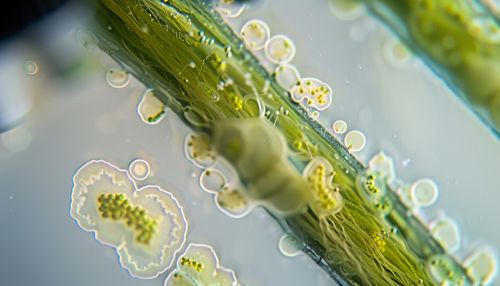Stem Endophytes: Difference between revisions
(Created page with "== Introduction == Stem endophytes are microorganisms, primarily bacteria and fungi, that reside within the internal tissues of plants without causing any apparent harm to their host. These endophytes are found in various plant parts, including stems, leaves, roots, and seeds. They play a crucial role in plant health, growth, and adaptation to environmental stressors. This article delves into the biology, ecology, and potential applications of stem endophytes, pr...") |
No edit summary |
||
| Line 49: | Line 49: | ||
* [[Biocontrol]] | * [[Biocontrol]] | ||
[[Image:Detail-93353.jpg|thumb|center|Close-up of plant stem with visible endophytes under a microscope.|class=only_on_mobile]] | |||
[[Image:Detail-93354.jpg|thumb|center|Close-up of plant stem with visible endophytes under a microscope.|class=only_on_desktop]] | |||
== Categories == | == Categories == | ||
Latest revision as of 10:04, 22 June 2024
Introduction
Stem endophytes are microorganisms, primarily bacteria and fungi, that reside within the internal tissues of plants without causing any apparent harm to their host. These endophytes are found in various plant parts, including stems, leaves, roots, and seeds. They play a crucial role in plant health, growth, and adaptation to environmental stressors. This article delves into the biology, ecology, and potential applications of stem endophytes, providing a comprehensive overview of their significance in plant science.
Biology of Stem Endophytes
Types of Stem Endophytes
Stem endophytes can be broadly classified into bacterial and fungal endophytes. Bacterial endophytes belong to various genera, including Pseudomonas, Bacillus, and Enterobacter. Fungal endophytes are often from the genera Aspergillus, Penicillium, and Fusarium. These microorganisms colonize the intercellular spaces and vascular tissues of the plant stems.
Colonization and Transmission
The colonization process of stem endophytes begins with the entry of microorganisms through natural openings such as stomata or wounds. Once inside, they proliferate and spread to different plant tissues. Transmission of endophytes can occur vertically, from parent to offspring through seeds, or horizontally, from the environment or other plants.
Symbiotic Relationships
Stem endophytes engage in various symbiotic relationships with their host plants. These relationships can be mutualistic, where both the plant and the endophyte benefit, or commensalistic, where the endophyte benefits without affecting the plant. Mutualistic endophytes often enhance plant growth, nutrient uptake, and resistance to pathogens.
Ecology of Stem Endophytes
Habitat and Diversity
Stem endophytes are ubiquitous and can be found in diverse plant species across different ecosystems. The diversity of endophytes within a single plant species can be influenced by factors such as the plant's genotype, environmental conditions, and soil microbiome.
Environmental Adaptation
Endophytes play a significant role in helping plants adapt to various environmental stressors, including drought, salinity, and heavy metal contamination. They achieve this by producing bioactive compounds that enhance the plant's stress tolerance mechanisms.
Interaction with Other Microorganisms
Stem endophytes interact with other microorganisms in the plant's microbiome, including rhizobia, mycorrhizae, and phyllosphere bacteria. These interactions can influence the overall health and productivity of the plant.
Applications of Stem Endophytes
Agricultural Applications
Stem endophytes have significant potential in sustainable agriculture. They can be used as biofertilizers to enhance nutrient uptake, as biocontrol agents to protect against pathogens, and as bio-stimulants to promote plant growth. Research is ongoing to develop endophyte-based products for commercial use.
Phytoremediation
Endophytes can assist in the phytoremediation of contaminated soils by enhancing the plant's ability to uptake and detoxify pollutants. Certain endophytes produce enzymes that degrade organic contaminants or sequester heavy metals, making them valuable tools for environmental cleanup.
Biotechnology and Medicine
The bioactive compounds produced by stem endophytes have potential applications in biotechnology and medicine. These compounds include antibiotics, antifungals, and anticancer agents. The exploration of endophyte-derived natural products is a growing field of research.
Challenges and Future Directions
Identification and Isolation
One of the primary challenges in studying stem endophytes is the identification and isolation of specific strains. Traditional culturing methods often fail to capture the full diversity of endophytes present in plant tissues. Advances in metagenomics and next-generation sequencing are helping to overcome these limitations.
Understanding Mechanisms
While the benefits of stem endophytes are well-documented, the underlying mechanisms of their interactions with host plants are not fully understood. Further research is needed to elucidate the molecular and biochemical pathways involved in these symbiotic relationships.
Commercialization and Regulation
The commercialization of endophyte-based products faces regulatory challenges. Ensuring the safety and efficacy of these products requires rigorous testing and compliance with agricultural and environmental regulations. Collaborative efforts between researchers, industry, and regulatory bodies are essential for the successful integration of endophytes into mainstream agriculture.
See Also


